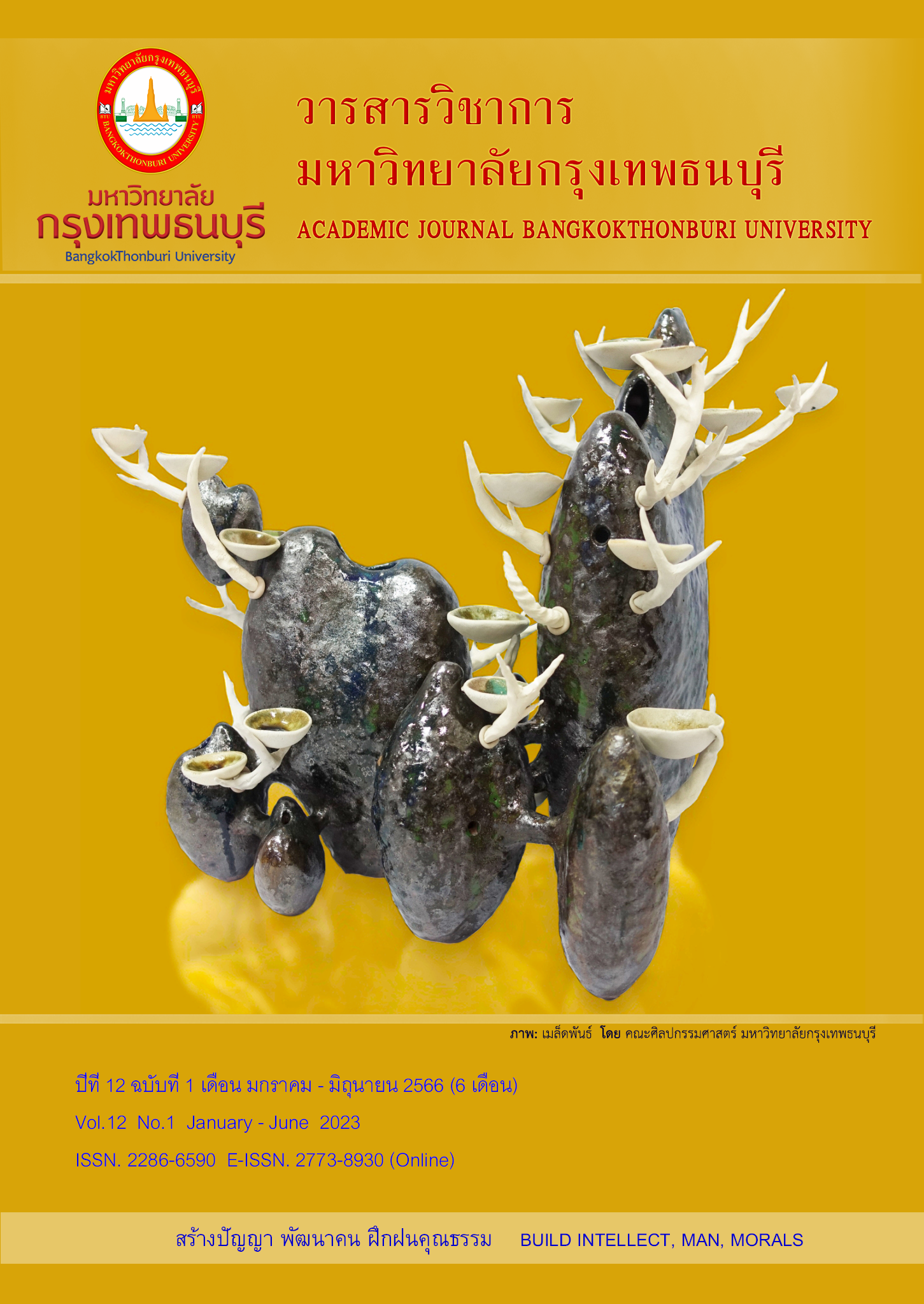The Effect of Motivational and Hygiene Factors on Job Applicatioln in Technology Industry
Main Article Content
Abstract
This research is a quantitative study, with an analysis of variance and a multiple regression analysis, aimed at examining the motivation and hygiene factors that influence job applications in the technology industry among Generation Z, Generation Y, and Generation X in 2023. In addition to the motivation and hygiene factors, a literature review revealed that Generation Z demonstrates different job selection behaviors and values compared to other generations. Therefore, the research incorporates the Person-organization fit theory in a kind of supplementary fit, which includes values reinforced by organizational and individual preferences, as one of the factors to be studied.
Data was collected through an online questionnaire, with a total of 400 sets of responses. The sample group consisted of: 1) Age groups are divided into three categories: 21-26 years old, representing 69% of the sample (Generation Z), 24-42 years old, representing 28% of the sample (Generation Y), and 43-58 years old, representing 3% of the sample (Generation X). 2) Educational levels divided into three categories: below bachelor's degree or currently pursuing a bachelor's degree, representing 21% of the sample, bachelor's degree, representing 72% of the sample, and beyond bachelor's degree, representing 7% of the sample. 3) Work experience groups divided into four categories: less than 1 year of work experience, representing 33% of the sample, 1-2 years of work experience, representing 30% of the sample, 3-4 years of work experience, representing 22% of the sample, and more than 4 years of work experience, representing 15% of the sample.
The research findings indicate that both Generation Z, Generation Y, and Generation X are influenced by a recognition for achievement factor, a group of motivation factor, as well as a person-organization fit with supplementary fit factor. These factors are influential in job applications, but the level of influence varies based on educational levels and work experience.
Article Details

This work is licensed under a Creative Commons Attribution-NonCommercial-NoDerivatives 4.0 International License.
References
กิตติธัช พันธุ์เปรม. (2564). ปัจจัยที่มีผลต่อการตัดสินใจเลือกเข้าทำงานบริษัทค้าปลีก ของ Generation Z ในประเทศไทย. สารนิพนธ์มหาบัณฑิต. มหาวิทยาลัยมหิดล.
คุณิตา ไตรอังกูร. (2562). ปัจจัยที่มีอิทธิพลต่อการตัดสินใจเลือกเข้าทำงานในองค์กรของกลุ่ม Genaration Z. สารนิพนธ์ปริญญาการจัดการมหาบัณฑิต. มหาวิทยาลัยมหิดล.
ชาคริยา พุทธปวน. (2557). ปัจจัยที่ดึงดูดให้บุคลากรอยากมาสมัครงานกับองค์กร. การค้นคว้าอิสระหลักสูตรบริหารธุรกิจมหาบัณฑิต. มหาวิทยาลัยธรรมศาสตร์.
ธนันยพร สุวรรณคาม. (2559). ปัจจัยด้านแรงจูงใจในการทำงาน ความพึงพอใจในงาน ที่ส่งผลต่อความผูกพันต่อองค์การของพนักงานธนาคารพาณิชย์แห่งหนึ่ง. งานวิจัยส่วนบุคคลหลักสูตรศิลปศาสตรมหาบัณฑิต. มหาวิทยาลัยธรรมศาสตร์.
บริพัตร ดะรีพัตร์. (2560). ผลของการนำเสนอข้อมูลความสอดคล้องระหว่างบุคคลกับองค์การที่มีผลต่อความตั้งใจสมัครงาน. วิทยานิพนธ์ศิลปะศาสตร์มหาบัณฑิต. มหาวิทยาลัยธรรมศาสตร์.
บวรรัตน์ ธนาฤทธิวราภัค. (2561). ปัจจัยความน่าดึงดูดของนายจ้างที่มีอิทธิพลต่อความตั้งใจสมัครงานของกลุ่มคนเจเนอเรชั่นแซด ที่กำลังศึกษาอยู่ในระดับปริญญาตรี. การค้นคว้าอิสระ หลักสูตรบริหารธุรกิจมหาบัณฑิต. มหาวิทยาลัยธรรมศาสตร์.
ลัดดาวัลย์ เพชรโรจน์ และอัจฉรา ชำนิประศาสน์. (2547). ระเบียบวิธีการวิจัย = Research Methodology. กรุงเทพฯ: พิมพ์ดีการพิมพ์.
สิรีรัศมิ์ บุญประสพกุลทร. (2561). ความสัมพันธ์ระหว่างความสอดคล้องระหว่างบุคคลกับองค์การความสอดคล้องระหว่างบุคคลกับงาน และความผูกพันในงานของพนักงานเจนเนอเรชั่นวายในธุรกิจอาหารและเครื่องดื่มแห่งหนึ่ง. สารนิพนธ์ปริญญาการจัดการมหาบัณฑิต. มหาวิทยาลัยมหิดล.
Asian Development Bank. (2022, September 15). Thailand’s Tech Startups Developing Rapidly. from https://www.adb.org/news/thailand-s-tech-startups-developing-rapidly.
Barhate, B., & Dirani, K. (2022). Career aspirations of generation Z: a systematic literature review. European Journal of Training and Development, 46(1-2), 139-157.
Chillakuri, B. (2020). Understanding Generation Z expectations for effective onboarding. Journal of Organizational Change Management, 33(7), 1277-1296.
Herzberg, F. (1968). One More Time: How Do You Motivate Employees?. Harvard Business Review, 81(1), 87-96.
Holopainen, L. & Suslova, A. (2019). Job Satisfaction and Employee Motivation: Case Generation Z. Bachelor of Business Administration International Business. KAMK University of Applied Sciences.
Kristof, A. (1996). Person-Organization Fit: An Integrative Review of its Conceptualizations, Measurement, and Implecations. Personnel Psychology, 49(1), 1–49.
Mahattanalai, T. (2021). Industry Outlook 2021-2023: Digital Services and Software. from https://www.krungsri.com/en/research.
Maslow, A.H. (1943). “A Theory of Human Motivation”. Psychological Review, 50(4), 430-437.
Mawhinney, T. & Betts, K. (2019). Understanding Generation Z in the workplace. Retrieved from Deloitte: https://www2.deloitte.com/us/en/pages/consumer-business/articles/understanding- generation-z-in-the-workplace.html
Mcleod, S. (2007). Maslow's Hierarchy of Needs. Retrieved from Simply Psychology. from https://www. simplypsychology.org/maslow.html
Ngoc, T. N., Dung, M. V., Rowley, C., & Bach, M. P. (2022). Generation Z job seekers’ expectations and their job pursuit intention: Evidence from transition and emerging economy. International Journal of Engineering Business Management, 14, 1-13.
Pardee, R. L. (1990). Motivation Theories of Maslow, Herzberg, McGregor & McClelland. A Literature Review of Selected Theories Dealing with Job Satisfaction and Motivation. Retrieved from ERIC: https://eric.ed.gov/?id=ed316767
Rattanakhamfu, S. (2021). Meeting new job demands in the post-Covid economy. TDRI annual public conference 2021. TDRI Insight.
Silverthorne, C. (2004). The impact of organizational culture and person‐organization fit on organizational commitment and job satisfaction in Taiwan. Leadership & Organization Development Journal, 25(7), 592-599.
White, M. (2019). Gearing up for Gen Z: An Analysis of Employers’ Recruitment Marketing Targeting the New, Generation Z, Workforce. Retrieved from Toronto Metropolitan University.


